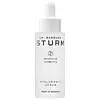What's inside
What's inside
 Key Ingredients
Key Ingredients

 Benefits
Benefits

 Concerns
Concerns

No concerns
 Ingredients Side-by-side
Ingredients Side-by-side

Water
Skin ConditioningButylene Glycol
HumectantAlpha-Glucan Oligosaccharide
CleansingPropanediol
SolventBifida Ferment Lysate
Skin ConditioningDimethylimidazolidinone Rice Starch
AbsorbentPanthenol
Skin ConditioningBuddleja Officinalis Flower Extract
UV FilterSodium Hyaluronate
HumectantAsiaticoside
AntioxidantAsiatic Acid
Skin ConditioningMaclura Cochinchinensis Leaf Prenylflavonoids
Madecassic Acid
Skin ConditioningLactic Acid
BufferingPropylene Glycol
HumectantCarbomer
Emulsion StabilisingEthylhexylglycerin
Skin ConditioningBenzyl Alcohol
PerfumingXanthan Gum
EmulsifyingPotassium Sorbate
PreservativeSodium Hydroxide
BufferingPantolactone
HumectantSodium Benzoate
MaskingAcetic Acid
BufferingCitric Acid
BufferingPhenoxyethanol
PreservativeTocopherol
AntioxidantWater, Butylene Glycol, Alpha-Glucan Oligosaccharide, Propanediol, Bifida Ferment Lysate, Dimethylimidazolidinone Rice Starch, Panthenol, Buddleja Officinalis Flower Extract, Sodium Hyaluronate, Asiaticoside, Asiatic Acid, Maclura Cochinchinensis Leaf Prenylflavonoids, Madecassic Acid, Lactic Acid, Propylene Glycol, Carbomer, Ethylhexylglycerin, Benzyl Alcohol, Xanthan Gum, Potassium Sorbate, Sodium Hydroxide, Pantolactone, Sodium Benzoate, Acetic Acid, Citric Acid, Phenoxyethanol, Tocopherol
 Reviews
Reviews

Ingredients Explained
These ingredients are found in both products.
Ingredients higher up in an ingredient list are typically present in a larger amount.
Butylene Glycol (or BG) is used within cosmetic products for a few different reasons:
Overall, Butylene Glycol is a safe and well-rounded ingredient that works well with other ingredients.
Though this ingredient works well with most skin types, some people with sensitive skin may experience a reaction such as allergic rashes, closed comedones, or itchiness.
Learn more about Butylene GlycolEthylhexylglycerin (we can't pronounce this either) is commonly used as a preservative and skin softener. It is derived from glyceryl.
You might see Ethylhexylglycerin often paired with other preservatives such as phenoxyethanol. Ethylhexylglycerin has been found to increase the effectiveness of these other preservatives.
Phenoxyethanol is a preservative that has germicide, antimicrobial, and aromatic properties. Studies show that phenoxyethanol can prevent microbial growth. By itself, it has a scent that is similar to that of a rose.
It's often used in formulations along with Caprylyl Glycol to preserve the shelf life of products.
Potassium Sorbate is a preservative used to prevent yeast and mold in products. It is commonly found in both cosmetic and food products.
This ingredient comes from potassium salt derived from sorbic acid. Sorbic acid is a natural antibiotic and effective against fungus.
Both potassium sorbate and sorbic acid can be found in baked goods, cheeses, dried meats, dried fruit, ice cream, pickles, wine, yogurt, and more.
You'll often find this ingredient used with other preservatives.
Learn more about Potassium SorbateSodium Hyaluronate is hyaluronic acid's salt form. It is commonly derived from the sodium salt of hyaluronic acid.
Like hyaluronic acid, it is great at holding water and acts as a humectant. This makes it a great skin hydrating ingredient.
Sodium Hyaluronate is naturally occurring in our bodies and is mostly found in eye fluid and joints.
These are some other common types of Hyaluronic Acid:
Learn more about Sodium HyaluronateWater. It's the most common cosmetic ingredient of all. You'll usually see it at the top of ingredient lists, meaning that it makes up the largest part of the product.
So why is it so popular? Water most often acts as a solvent - this means that it helps dissolve other ingredients into the formulation.
You'll also recognize water as that liquid we all need to stay alive. If you see this, drink a glass of water. Stay hydrated!
Learn more about Water